
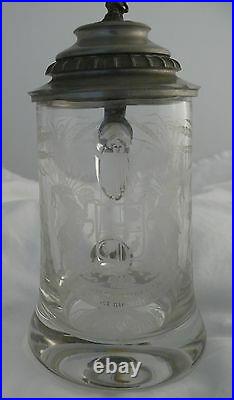
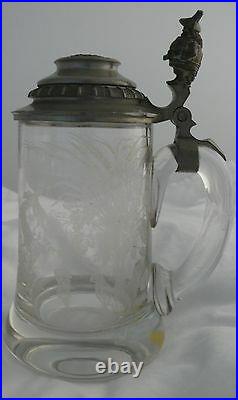
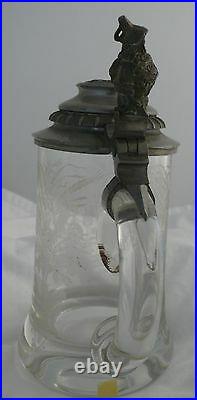
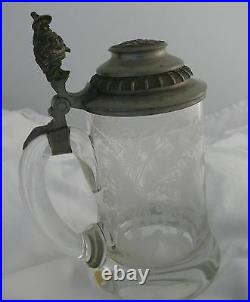

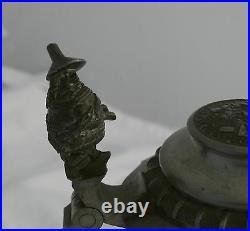

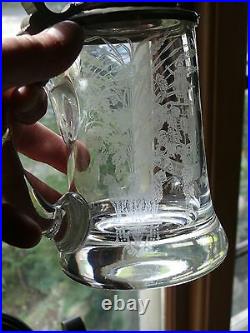
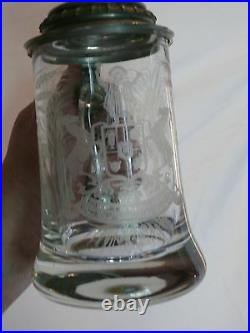
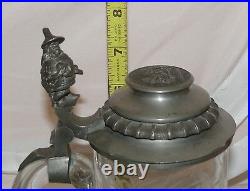

German lidded stein leaded glass cut etched glass and character in barrel with funnel hat ornamental top. See photos for greater details Measures 8 inches in height. A large collection of antique beer steins from the estate of a serious collector. We will list as many steins as possible for your entertainment see photos. Antique beer steins, mugs and tankards are prized for their craftsmanship and colorful ornamentation and scenes. They can be found in many styles and materials, including copper, pewter, silver, pottery, ivory, porcelain, glass and wood. Many steins were imported to the U. From Germany in the late 19th and early 20th centuries, especially from the city of Mettlach, whose potteries produced thousands of the vessels. The beer stein had its origins in the mid-1500’s along the Rhine river in Germany, when sm. All towns began producing functional drinking vessels decorated by enameling and glazing. Each town or area adding their own flair or nuance. Factories around Westerwald and Dresden began producing ornamental steins for display, and continued doing so until WW1, from which the industry never fully recovered. Lately there’s been renewed interest in collecting beer steins with unique designs, including reproductions of works by famous artists. Designs reflect everything from historical battles to comical faces and even car racing and baseball. While many steins have been produced and marketed as collectibles, the most valuable continue to be pre-1900 German handmade steins. From Wikipedia, the free encyclopedia. This article needs additional citations. Please help improve this article. By adding citations to reliable sources. Unsourced material may be challenged. For either traditional beer mugs made out of stoneware. Or specifically ornamental beer. Such Steins may be made out of stoneware. Rarely the inferior earthenware. They may have open tops or hinged pewter. Lids with a thumb- lever. Steins usually come in sizes of a half litre. Or a full litre (or comparable historic sizes). They are often decorated in a nostalgic manner, but with allusions to Germany. It is believed by some that the lid was implemented during the age of the Black Plague. To prevent diseased fleas from getting into the beer. Other forms and synonyms. Common half-litre Humpen or beer mug. Stein is an abbreviation of German Steingut stoneware. The common material for beer mugs before the introduction of glass. The word is not used within Germany. The word stein could have also originated from the German word Steinzeugkrug , meaning stoneware jug or tankard. By common usage, stein is referred to being a beer container with a handle and hinged lid. Bierstein in German means beerstone. Beer scale a hard residue of calcium oxalate. Protein, and sugar formed when a brewing vessel is used repeatedly without exacting cleaning. The stein originated around the 14th century. The spread of the bubonic plague throughout Europe forced Germany to take some precautions in preventing a catastrophe. A new German law was written, stating that all beverage containers needed a lid. During the next 300 or so years, Germany enforced many regulations on how their beer was to be produced and transported, while other European countries didn’t take such precautions. Thus German beer quickly became popular across Europe and demand for the beer increased as well. This demand made it a necessary search for inexpensive, yet durable material to transport large amounts of beer to different areas. Although many materials proved to be a sufficient material to use in creating beer steins, the most common materials used were glass, stoneware, and porcelain. In the latter half of the 19th century, stein makers found different advantages within the different materials. The advantage in using stoneware to make steins was that molds could be used to mass produce elaborately carved steins. In using glass, not only could one produce multiple glass mugs, but an artistic touch could add to the glass by including acid etchings, glass staining, or even multicolored overlays. Porcelain’s advantage was that a stein fabricator could use molds to make “character steins”, steins that had a particular shape modeled after an item or a person. Throughout the 1900s, collecting antique and replicated beer steins became very popular hobby not only among individual people, but in museums as well. Production of beer steins has become substantially large in America, but the largest producer of beer steins is Ceramarte of Brazil. The most traditional area of beer stein production is the Westerwald region in Germany called “Kannenbaeckerland”. This unique German potters region has been creating beer steins for centuries and is famous among the collectors as the original German beer stein producer. The item “GERMAN LIDDED STEIN LEADED CUT ETCHED GLASS BEER BARREL MAN FUNNEL TOP 1900’S” is in sale since Wednesday, May 16, 2012. This item is in the category “Collectibles\Breweriana, Beer\Drinkware, Steins\Lidded Steins\Germany”. The seller is “lhowardestates” and is located in Minneapolis, Minnesota. This item can be shipped worldwide.


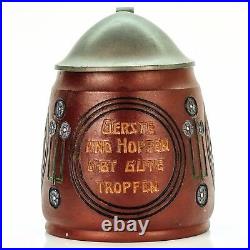
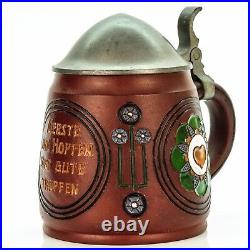
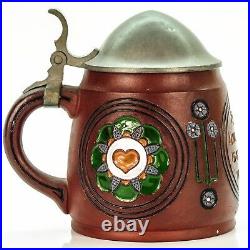
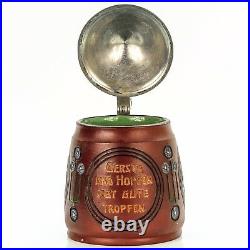
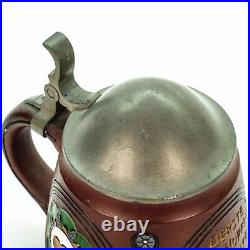
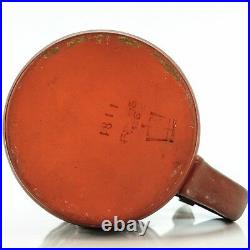












 D5 Creation
D5 Creation